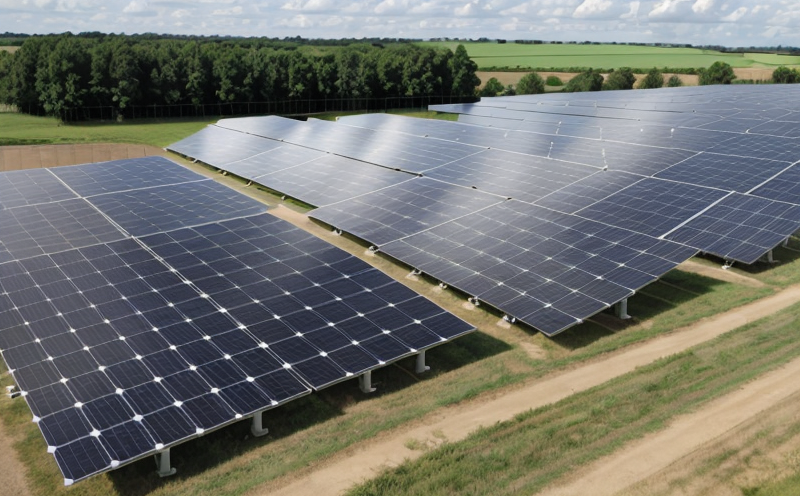ASTM E2939 Power Conversion Testing for Renewable Equipment
The ASTM E2939 standard is a critical tool in the testing of power conversion systems (PCS) used in renewable energy sources such as solar photovoltaic (PV), wind, and hybrid systems. This standard provides a framework to measure the efficiency, performance, and reliability of PCS under various environmental conditions. The standard ensures that these devices meet stringent performance criteria set by industry and regulatory bodies.
The testing process outlined in ASTM E2939 involves simulating real-world operating conditions to assess the power conversion efficiency and stability of renewable energy systems. This includes measuring the system's ability to convert DC (direct current) from solar panels or wind turbines into AC (alternating current) suitable for grid connection.
The standard is particularly important in ensuring that PCS meet environmental standards, which are crucial given the increasing emphasis on sustainable power generation and distribution. The testing procedure involves several key stages:
Installation of the PCS in a controlled environment where parameters such as temperature, humidity, and irradiance can be precisely controlled.
Application of various test conditions to simulate real-world scenarios, including different weather patterns and load variations.
Monitoring and recording performance metrics such as conversion efficiency, power factor, harmonic distortion, and stability under varying conditions.
The results from these tests are essential for manufacturers, quality managers, and compliance officers to ensure that their products meet the required standards. This ensures not only regulatory compliance but also enhances product reliability in harsh environments typical of renewable energy installations.
| Applied Standards | Description |
|---|---|
| ASTM E2939-18 | Standard Practice for Testing Power Conversion Systems in Renewable Energy Applications |
| IEC 61724-1:2015 | Performance of Photovoltaic (PV) Systems – Part 1: General Requirements |
The use of these standards ensures that the testing methods are consistent and comparable across different manufacturers, thereby promoting fair competition and quality assurance.
Why It Matters
The importance of ASTM E2939 Power Conversion Testing for Renewable Equipment cannot be overstated. By ensuring that power conversion systems meet the highest standards, this testing process plays a pivotal role in enhancing the efficiency and reliability of renewable energy systems.
Enhanced Efficiency: Ensures that the system operates at peak performance, maximizing the amount of usable electricity generated from renewable sources.
Improved Reliability: Identifies potential weaknesses or failures before they occur, leading to extended operational life and reduced downtime.
Compliance with Regulations: Guarantees adherence to international standards and local regulations, ensuring that products are fit for purpose in the market.
The testing process is particularly crucial given the increasing demand for renewable energy sources. By adhering to these stringent tests, manufacturers can ensure their products contribute positively to environmental sustainability while maintaining high performance levels.
Applied Standards
| Standard Code | Description |
|---|---|
| ASTM E2939-18 | Standard Practice for Testing Power Conversion Systems in Renewable Energy Applications |
| IEC 61724-1:2015 | Performance of Photovoltaic (PV) Systems – Part 1: General Requirements |
The application of these standards ensures that the testing methods are consistent and comparable across different manufacturers, thereby promoting fair competition and quality assurance.
Industry Applications
Solar PV Systems: Ensures that inverters and converters operate efficiently under varying conditions, maximizing energy output.
Wind Energy Systems: Tests the performance of power conversion systems in different wind speeds and environmental conditions.
Hybrid Systems: Evaluates the efficiency of combined solar and wind systems to ensure optimal performance across diverse environments.
| Industry Applications | Description |
|---|---|
| Solar PV Systems | Ensures that inverters and converters operate efficiently under varying conditions, maximizing energy output. |
| Wind Energy Systems | Tests the performance of power conversion systems in different wind speeds and environmental conditions. |
| Hybrid Systems | Evaluates the efficiency of combined solar and wind systems to ensure optimal performance across diverse environments. |
The results from these tests are essential for manufacturers, quality managers, and compliance officers to ensure that their products meet the required standards. This ensures not only regulatory compliance but also enhances product reliability in harsh environments typical of renewable energy installations.





